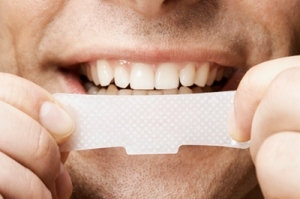When something is commonplace, it is assumed to be safe – correct? Many people believe if whitening teeth were bad, someone would step in and stop the sale of bleaching products. The whitening industry has been growing rapidly over the past 10 years and currently generates over $11 billion a year. It is no wonder that we now have a huge turf fight, with dentistry trying to stop non-dentists from whitening teeth in malls and beauty parlors. Both sides are taking their cases to court, with non-dentists claiming that to make whitening a dentist-only treatment is giving dentists the monopoly in this lucrative business. You, my friends, have the teeth that everyone wants to bleach!
It is interesting that both sides claim the risks from bleaching “are minimal”. The American Academy of Cosmetic Dentistry admits there is a problem of sensitivity after bleaching and hold this as one reason it should be a dentist-only treatment. The AACD admit that bleaching a decayed tooth can kill the nerve and result in the need for a root canal or extraction. I hope to help you get beyond the noise about who should get the money and help you learn the truth: the fact that researchers are ringing an alarm bell and telling us about the danger from bleaching teeth. But no one is listening– at least, not yet.
Deleterious effects
A short time ago an Englishman was jailed for 16 months for selling tooth-whitening products that contained peroxide 103 times stronger than is allowed by the U.K. legal limit. The Irish Dental Association warns about tooth whitening and the European Commission has regulated the use of hydrogen peroxide to allow only qualified dentists to whiten teeth. Products containing more than 6% hydrogen peroxide are illegal to use in the U.K, even by dentists.
 35% hydrogen peroxide is used in most US bleaching products, both in office and also in home-applied products. A 2012 study shows that this concentration of peroxide can cause changes in the tooth enamel that make it rough and a loss of strength and phosphate content in deeper layers.
35% hydrogen peroxide is used in most US bleaching products, both in office and also in home-applied products. A 2012 study shows that this concentration of peroxide can cause changes in the tooth enamel that make it rough and a loss of strength and phosphate content in deeper layers.
This study, published in the Journal of Dental Research, included men and women 18-25 who had good teeth, but needed extractions. Test subjects had bleached their teeth once per week with 35% H2O2 per the manufacturer’s instructions. At the end of the study, the teeth were extracted and viewed under a microscope. Deep porosities were seen and the dentin had an increase in enzymes that break down collagen and disrupt the organic matrix. “The bleaching agent could potentially trigger biological and/or mechanical responses,” the study warns. “Dentists should be aware that sensitivity after bleaching is due to an inflammation in the pulp that can progress to undesirable pathology.”
What this means is that the researchers saw molecular changes following the bleaching, and that it also had a dramatic impact on the inner live pulp. As a result of these findings, the researchers expressed concern about the common characterization of tooth whitening. They wrote: “despite reports that bleaching has been considered absolutely safe, analysis of our data shows that 35% H2O2 as a bleaching agent … can be clinically adverse in the long-term and/or after recurring bleaching treatments.” If you have read my chapter on whitening in Kiss Your Dentist Goodbye, you will be familiar with my warnings about bleaching which are similar.
Researchers in this field optimistically hope their study information will reach patients. “We would like to demonstrate that in-office bleaching is far from a (safe) cosmetic procedure, and it would be great if clinicians could explain better to patients the pros and cons ….”
No reversal of damage
The researchers are naïve, and the marketing folks at the whitening-product companies have an easy task, since everyone wants white teeth. Most people are unaware of any dangers, or they believe that any problems can be reversed by tooth-strengthening pastes. The fact is that these can only give a temporary benefit (for 7-14 days) after which time the tooth-weakness returns. A 2013 study showed that re-mineralizing pastes did not help tooth enamel recover its micro-hardness after dental-office teeth whitening (with 35% to 38% hydrogen peroxide), Acta Odontologica Scandinavica (March 2013, Vol. 71:2, pp. 343-348).Microhardness change of enamel due to bleaching with in-office bleaching gels of different acidity Juliana G. Magalhães, Ângela R. K. Marimoto, Carlos R. G. Torres, Clovis Pagani, Symone C. Teixeira, and Daphne C. Barcellos
Damage to fillings
Another problem is that hydrogen peroxide (even at dilute concentration) may release mercury from silver fillings and cause them to deteriorate (possibly allowing toxins into your digestive system or body). At the end of every day, dental office waste drains are cleaned with a variety of different products. In 2006 a studyevaluated these drain-cleaners, and one fascinating result of the study was that some of the cleaning products (including peroxide) caused mercury vapor to be released from discarded pieces of silver filling found down the drains. A more specific study should be designed before conclusions are drawn, but it seems important to know if peroxide causes deterioration of silver fillings.
Sursa: Articol este scris de Dr Ellie Phillps The Negative Effects of Bleaching Teeth
Articol scris in romana de Dr Resit Ayla despre Efectele negative ale albirii dintilor
Niciun comentariu:
Trimiteți un comentariu